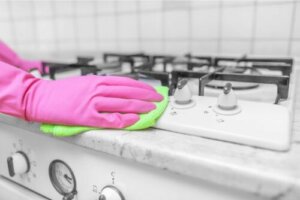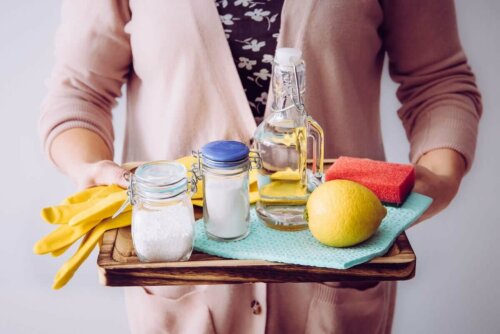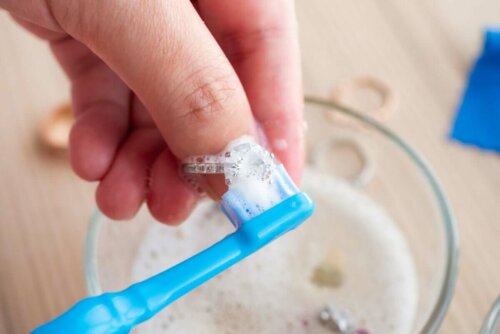Vinegar as a Disinfectant Around the House

Surely you’ve heard that vinegar is a great disinfectant around the house – besides being an extraordinary culinary compliment, of course! People have been using it to clean the kitchen, bathroom, and other surfaces in the house for a while.
Vinegar as a cleaning product is quite efficient when it comes to eliminating unpleasant odors, removing dirt, and even grime. Some people mix it with other substances, such as baking soda, for more effective results.
However, you must be careful when you use it It’s definitely an efficient cleaner, but not so much so as a disinfectant. Continue reading to find out what are the best uses for vinegar and when to use a disinfectant.
Is vinegar a good household disinfectant?
Yes and no. The terms cleaning and disinfecting are different, even though people use them interchangeably. Thus, cleaning products remove dirt, debris, and even some germs from a given surface.
In contrast, disinfectants actually kill or neutralize bacteria, viruses, and germs. Having made this clarification, rest assured that vinegar is an excellent natural cleaning product. This is because it contains 5% acetic acid and this is more than plenty when it comes to removing dirt, dust, and grease residues.
As we mentioned above, vinegar isn’t a great disinfectant so its uses in this regard are quite limited. For instance, it’s only good against certain types of harmful microorganisms such as Salmonella and E. coli. Read on to find two case studies about the disinfecting properties of vinegar.

1. Disinfection of toothbrushes
This is one of the most common uses of vinegar around the house. Some comparative studies confirm that vinegar has better results in disinfecting toothbrushes than triclosan, a type of mouthwash. The test consisted of soaking the brushes in both liquids separately for two minutes and then determining which bacteria each of these killed.
Note that the effectiveness of the vinegar isn’t limited to Escherichia coli. However, it didn’t entirely neutralize the other types of bacteria present in these brushes.
2. Disinfection of vegetables
According to research, dipping lettuce leaves in a vinegar solution reduces the presence of E. coli bacteria in this vegetable. Also, it doesn’t affect their texture or flavor.
However, its properties as a disinfectant are limited for this purpose and thus, researchers don’t recommend it.
Find out some Natural Ways to Deodorize Your Bathroom
What are the best disinfectants?
These substances should be able to kill 99.9% of harmful germs within 5 to 10 minutes after application. Furthermore, these types of products usually contain substances such as ethanol (ethyl alcohol), isopropanol, hydrogen peroxide (hydrogen peroxide), phenolic compounds, and bleach or hypochlorite.
Also, the products are available on the market in the form of sprays, liquids, tablets, gels, or wet wipes. The important thing here is to check the label and make sure it contains some of these substances.
Is vinegar a good disinfectant?
It definitely is, but with limitations. It’s mainly an environmentally friendly product that’ll ease your household cleaning chores. For example, you can use it to clean windows and other surfaces as well as pools, pipes, kitchen, appliances, and showers, among others.
However, acetic acid [contained in vinegar] isn’t recommended for just about any surface. It can damage waxed wood, granite, marble, cast iron, and aluminum.
Here are some ways to use vinegar as a cleaning product.
1. Pipe cleaner
This way to use vinegar won’t just help you unclog the drains in your home, but you’ll also be able to remove mold and mineral deposits.
All you have to do is pour three cups of boiling water into the clogged pipe and add one cup of baking soda. Then, add a cup of vinegar mixed with some water. Wait 10 minutes and pour 2 cups of boiling water again.
2. Remove stains in cups
To get rid of stains in cups just place a teaspoon of baking soda and a teaspoon of vinegar inside them. Stir, let it do its thing for a few minutes, and then just rinse it as usual.
3. Thoroughly clean the microwave
You don’t need a powerful degreaser to sanitize the microwave, a solution of 1/4 vinegar with 3/4 water will do. Just place it inside the oven for a few seconds or until it starts to release steam. Finally, remove any remaining dirt with a damp cloth.

Never mix vinegar with bleach because it leads to the off-gassing of harmful substances.
A recipe for a vinegar cleaning solution
You’ll need the following to make your own vinegar-based household cleaner:
- 1/2 c. of distilled white vinegar
- 2 c. of distilled or filtered water
- A spray bottle
- Just mix everything in a spraying bottle and use it to clean any surface; then, wipe it with a clean cloth
Learn about Four Toxin-Free Cleaners for Your Home
Vinegar is useful as a household disinfectant, but be careful!
In short, vinegar isn’t a reliable disinfectant to use around your house but it’s definitely an effective cleaner. Here are some recommendations to clean and disinfect your spaces:
- First, air your rooms before using any products to disinfect them.
- Sterilize the objects you use the most and often forget to clean such as doorknobs, light switches, controls, and phones (Use 70% alcohol for this purpose).
- Read the labels of cleaning products before using them and always follow the manufacturer’s advice.
All cited sources were thoroughly reviewed by our team to ensure their quality, reliability, currency, and validity. The bibliography of this article was considered reliable and of academic or scientific accuracy.
- Uzárraga, J. L. (2017). Desinfectante Y Gel Anti-Bacterial, Teniendo Como Base A La Flor De Jamaica(Doctoral dissertation, Instituto Tecnológico De Durango).
- Rodríguez-Angeles, G. (2002). Principales características y diagnóstico de los grupos patógenos de Escherichia coli. salud pública de méxico, 44(5), 464-475.
- Gaona Tapia, M. E. (2014). Estudio comparativo entre el vinagre y el triclosán como sustancias alternativas para la desinfección de cepillos dentales (Bachelor’s thesis, Quito: Universidad de las Américas, 2014.).
- Kahrs, R. F. (1995). Principios generales de la desinfección. sci. tech. Off. int. Epiz, 14(1), 143-163.
- Souza, Giovanna C, Spinosa, Wilma A, & Oliveira, Tereza CRM. (2018). Sanitizing action of triple-strength vinegar against Escherichia coli on lettuce. Horticultura Brasileira, 36(3), 414-418.
- Diomedi, Alexis, Chacón, Eiiana, Delpiano, Luis, Hervé, Beatrice, Jemenao, M. Irene, Medel, Myriam, Quintanilla, Marcela, Riedel, Gisela, Tinoco, Javier, & Cifuentes, Marcela. (2017). Antiseptics and disinfectants: aiming at rational use. Recommendations of the Advisory Committee on Healthcare Associated Infections. Sociedad Chilena de Infectología. Revista chilena de infectología, 34(2), 156-174.
This text is provided for informational purposes only and does not replace consultation with a professional. If in doubt, consult your specialist.








